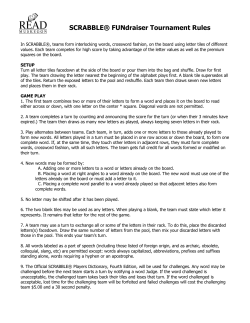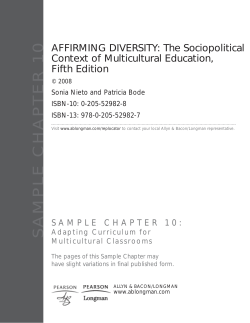
Cambodian Children’s Games Village Life in Cambodia—ALWS Awareness Week 2014 Bay Khom
Village Life in Cambodia—ALWS Awareness Week 2014 Cambodian Children’s Games Children in Cambodia have fun just as children everywhere do; they laugh, jump, run and swim. Most Cambodian children, especially those in villages, play with whatever they can find around them. Here are some games they play. Bay Khom A game played by two children. Ten holes are dug in the shape of an oval board in the ground. The game is played with 42 small beads, stones or fruit seeds. Before starting the game, five beads are put into each of the two holes located at the tip of the board. Four beads are placed in each of the remaining eight holes. play the hen leading and protecting many chicks. Another person is picked to be the crow. While both sides sing a song of bargaining, the crow tries to catch as many chicks as possible as they hide behind the hen. Chol Chhoung A game played by two groups of boys and girls. Two groups of 10 or 20 people stand in two rows opposite each other. One group throws the "chhoung" (a piece of The first player takes all the beads from any hole and scarf rolled into a ball of the size of a bare coconut and drops them one by one in the other holes. He must repeat tied at the end to form a tail used for holding and this process until he has dropped the last bead into a hole throwing. ) to the other group. When it is caught, it will be lying beside an empty one. Then he must take all the rapidly thrown back to the first group. If someone is hit by beads in the hole that follows the empty one. At this the "chhoung," the whole group must dance to get the point, the second player begins to play. The game ends "chhoung" back while the other group sings. when all the holes are empty. The player with the greatest number of beads wins the game. Leak Konsaeng A game played by a group of children sitting in circle. A Konsaeng is a scarf that is twisted on each end in opposite directions then folded in half to form a twisted rope. The ends are tied together as a knot to hold the twisted scarf. The end knot is served as a tail used for gripping and swinging by players. Players can swing to hit another player typically from the waist down as agreed by the team. Someone holding a konsaeng walks around the circle while singing a song. He then secretly places the Bos Angkunh konsaeng behind one of the children. If that chosen child A game played by two groups of boys and girls. realizes what is happening, he One team places their "angkunhs" on the ground in a semicircle. The other team, standing a few meters away, or she must pick up the "kanseng" and beat the throws their own angkunhs to hit the angkunhs on the ground. If your angkunh is knocked over, you lose and the person sitting next to him or winner get to knock two angkunhs held together against her. your knee. If the knocking fails to produce a clacking Tres sound, you get to knock his/her knee back. Be prepared A game played by throwing for sore knees! and catching a ball with one hand while trying to catch an Chab Kon Kleng increasing number of sticks A game played by imitating a hen as she protects her with the other hand. Usually, chicks from a crow. pens or chopsticks are used as Players usually appoint a person with a strong build to the sticks to be caught. For further information contact Email: alws@alws.org.au Ph: 1300 763 407 Web: www.alws.org.au Australian Lutheran World Service Awareness Week 2014 Village Life in Cambodia Dare to Dream a Different World Village Life in Cambodia—ALWS Awareness Week 2014 Cambodian Children’s Games Teagn Prot (Tug-of-War) Teagn Prot is a tug-of-war game with teams of boys and girls pitting their strengths by pulling on the rope. Teagn Prot has a number of significant stories in Khmer culture as seen in the folktales below. Its hidden meanings extend into historical and religious realms. This game requires a 30 feet rope the size of a small wrist and a noise making tool such as a drum to signal the start of the game. You divide the players into two teams of at least 5 to 10 people per team. This is usually the girls vs. guys. Each team does not necessary have the same number of people but rather depends on size and strength. The rule is to have at least 2 more people on the girl's team than the guy's team. The suggested arrangement is to use the strongest people at the end of the robe and at the front of each team. On the rope, mark the centre by tying a colour knot. The rope is laid in a straight line and each team will take one side about 5 feet passed the centre mark. To start, the person with the drum stands in the centre between the two teams and yells "Yeak Orr" with a long drawn-out manner. Then the teams will yell "Ho Vueyyy" in a similar style. This is repeated three times then the drum beats the signal for the teams to start pulling. As the game starts, the drummer can continue to beat to assist the teams. When a team is pulled over where the colour knot passes the marked line, the other team wins the game. Folktale 1 Once upon a time there was a group of giants who felt that the angels didn’t have more power than them. But the angels were more powerful because the Siva (a supreme divine being) had blessed them with power. The team of giants boasted that the angels would lose in a competition of strength. As the angels heard that, they replied that they were not afraid. The giants and the angels agreed to pit their strengths against one another in a tug-of-war competition. If the giants won, the giants would receive higher status by sitting in a higher location than the angels including those times they met with Siva. The angels were walking back and forth in front of Siva's courtyard trying to figure out a sure way to win the competition when Pealy (the King of the monkey who was aware of the competition) told them of a trick that guaranteed victory. The next day, the competition between the angels and giants began. The rope used in the competition was the serpent. The angels requested to have the head side of the serpent and the giants agreed. The angels used the trick mentioned by Pealy which was to have one angel use his finger to rub the belly button of serpent. As the serpent is tickled it swings its tail back and forth loosening the grips of the giants at the tail-end. The angels won the tug-ofwar. Folktale 2 The giants and angels came together to stir and dry out the ocean to get the elixir of life so that they could live forever. They used a serpent named Vasuki as the rope to move and turn Montakrak Mountain. Vishnu, a powerful god, turned himself into a turtle to prop up the mountain. The angels pulled at the head of the serpent while the giants pulled at the tail. When turning, the serpent got dizzy and threw up the balk poison and breathed fire through its tongue. This creates rain in the celestial sphere. For further information contact Email: alws@alws.org.au Ph: 1300 763 407 Web: www.alws.org.au http://www.cambodiaadoptionconnection.com/home/chaul-chnam-thmey/gamesand-activities http://www.cam-cc.org/calendar/newyear_game_teagnprot.php Australian Lutheran World Service Awareness Week 2014 Village Life in Cambodia Dare to Dream a Different World Village Life in Cambodia—ALWS Awareness Week 2014 Cambodian Children’s Games Cambodian School Game Cambodian students playing Si Khuong during school break What do children do in their school breaks? In Cambodia, there is a popular game Cambodian students love to play in their ten-minute breaks between each lesson. Sokhan Khut, describes the game. ‘Si Khuong’ or ‘Ou Chen’ is the name of the most popular Cambodian school game. Especially students of primary and lower secondary schools love to play it. To play this quite energetic game, you need a plain area in the school yard and at least eight people. The game is played as followed: The playing field consists of a table with 2 columns and 2 (or 3 or more) rows. It is drawn on the ground. If the ground is dirt, students use a stick or their feet to draw the lines. If the game is played on a concrete ground existing lines or sand can be used to draw the table. The width of each column is about 2.5 meters; the length of each row is about the same as the width of the column. Plan of the game The ‘guard’ crews can only move back and forth on their lines trying to touch the crew of the other side. The ‘forward’ stand on the front and the back lines of the table. They guards are not allowed to touch the forwards when they run in the table but they can touch them when they try to leave the table. When the game starts, the ‘forward’ crews are positioned in front of the front line of the table. They have to run back and forth along their lines and try to avoid not to be touched by the guards. Special rules: If four ‘forward’ crews stand in the same ‘block’ in the table they will lose the game automatically. If three of them stand in the same ‘block’ the ‘guard’ crews who stand on the lines of that block can crawl to touch them. When one of the ‘forward’ crew runs across the table and returns to the front without being touched he/she has to shout ‘Si Khuon’ and wins. If a crew can do this three The students form two groups, the crews. One crew (normally four students, but it depends on the number of times it wins the game. In the case that one of the crews is touched by a member of the ‘guard’ crew, all ‘forwards’ students participating). The crews are chosen pairing up the players or by the two crew chiefs picking their players. will have to take turn to be the ‘guard’ crews and follow their roles. The crews on one side of the field are called ‘guards’, those of the other side ‘forward’. The guards stand on the lines inside the table: One crew each on the horizontal line and on the vertical line in the middle of the table. The winner is rewarded by being allowed to gently clap the palms of the loser. The game has no official end except when classes start again or when the students are tired of playing. http://www.bookbridge.org/2012/07/cambodian-school-games/ For further information contact Email: alws@alws.org.au Ph: 1300 763 407 Web: www.alws.org.au Australian Lutheran World Service Awareness Week 2014 Village Life in Cambodia Dare to Dream a Different World
© Copyright 2025





















